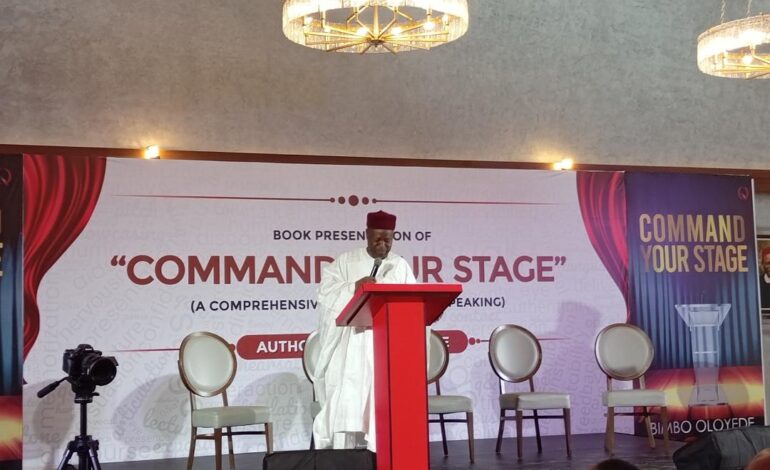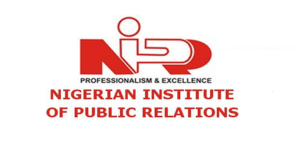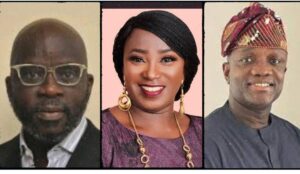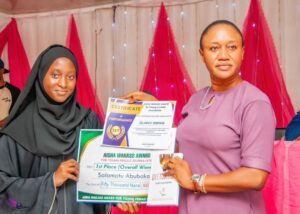“Command your stage” is a 272-page introspection, interrogation and examination of the art and science of public speaking and contextual presentation written by our dear author, broadcaster and speech presentation expert Mrs. Bimbo Oloyede.
The book is packaged and delivered in twelve chapters of precise, descriptive, unambiguous free-flowing prose laced with intellectual sagacity and journalistic expertise so much that the reader is likely to believe that Bimbo indeed has a Doctor of Philosophy degree in elocution as well as literature in English.
The depth of the linguistic prosecution of the message of the book is one of the finest and most lucid one has read in a very long time.
The author explores and utilizes the English language and choice of words with the dexterity of a seasoned literary colossus
The book opens with a prologue she aptly titles “The Power and the Glory”. For the author “There is something almost mystical about being able to speak effectively in public. Something about talking to an audience that somehow elevates the speaker above the crowd. It goes beyond the physical placement of speaker by transporting them to a higher level. This is a power that cannot really be expressed, because it cannot really be explained”
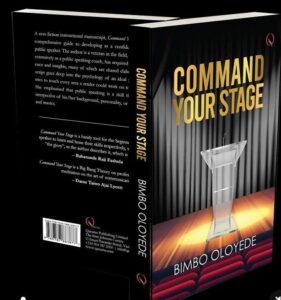
She goes ahead to elucidate about the concept of glory. She says “The glory is that pin drop silence in the hall when you can see the intensity of the absorption on the faces in the audience. You can feel the glory, when at the end of presentation, even the most comfortable in their chairs rise energetically to give the speaker a standing ovation. She goes ahead to give examples of Kings and Queens of the Power and the glory” Reverend Martin Luther King jnr, Nelson Mandela , Barack Obama, Sir Abubakar Tafawa Balewa, Chief Obafemi Awolowo, Dr Nnamdi Azikwe and of course Alh Yusuf Maitama Sule, Nigeria’s former Representative to the United Nations.
Chapter One focuses on the big question “What is Presentation ? According to the author, presentation is both an art and also a science because the intrinsic elements of an art is an “acquired habit of thinking , making or doing something with such regularity that the practitioner becomes unconsciously competent and skilled, while science is a concerted effort to obtain knowledge in order to attain a better understanding of nature through observation , experimentation under controlled conditions .
For her, the whole essentials of art and science are in presentation, especially when recounting or arranging the events or ideas in a logical order or sequence. Combining these three components makes a desirable quality presentation effective as well. “Many opinions have been shared on this regard. While some argue that presentation is an art because of involves creativity, aesthesis and ability to engage. Others see it as a science because it involves the use of research , data and techniques. This chapter explains further after defining what presentation is , goes further to explain what presentation is not. It is not cheap talk, it is not small talk, it is not a conversation, it is not gossip, it is not haphazard, it not a time filler, it is not propaganda, it is not slande,r It is not miscommunication, it is not hate speech.
The author ended chapter one with a quote from renowned American business magnate Warren Buffet who says “If you can’t truly communicate and talk to other people and get across your ideas, you have no potential” (pg 27.)
Chapter two explores the question “Who needs presentation training”. The truth is we will all need to utilize at least one skill desirable from presentation training of one type or another. Whether you are speaking on a one on one situation a condolence visit, or a housewife who has ran out of foodstuff and needs to speak to her husband for more money, an employee seeking to get permission to excuse himself from work to take care of a sick relative or even as an Honorable member of House of Assembly seeking for votes, and and has to explain his manifesto to his constituents.
These are examples of type of people and situations that provoke the realisation that need presentation training (which involves phonetics and pronunciation) is a no-brainer when it comes to achieving optimum results in effective communication
Airport announcers, corporate executives, teachers, journalists, and indeed anyone and everyone that needs to interface with other people, audiences or voters , they all need presentation trainings, not just once but periodically.
Chapter three asks do you deserve an audience ? This is also a rhetorical question. She defines an audience and further states that you must know your audience, the composition of the audience and knowledge of the coloration and demographics of the set of people you are addressing or speaking up to. One useful takeaway from this chapter is where the author states categorically that “The height of arrogance for a speaker, a politician or position holder to assume that your audience is duty bound to listen to you It is not. The audience has played its part, it is there. You have to play your part by communicating effectively otherwise you would loose their attention within a few minutes of your presentation communicate with your audience”(page 75).
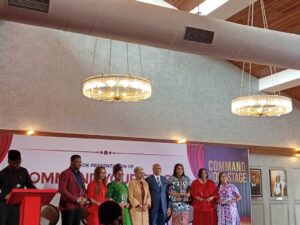
Speak to your audience not at them by utilizing words, phrases and sentences that invite their inclusion and welcome their participation. Try to blend into the environment. Being presentable is half the battle because you are to discover that if your look good and feel good, the chances are that you will give a good account of yourself. But also your performance should gain you recognition, not your attire.
On page 76, the author restates a quote from former American President Gerald Ford “If I went back to college again, I would concentrate on two areas. Learning to write and to speak before an audience. Nothing in life is more important than the ability to communicate effectively.”
In Chapter four we are faced with “The barriers to effective presentation”. These are Physiologic Psychological, Emotional, Educational, Socio-cultural, Technical, Political, The Question and Answer bogey, Tonal and the Physical.
There are so many ways to present, and each speaker must choose the method that is most appreciable for them, as well as the topic and also their audience. It is possible to influence audiences when you know who they are. Tailor your vocabulary, language and style to suit the needs and expectations of your audience. Another take away from this chapter is a quote by her in page 146 “Understand that like your voice, your material is an extension of you. If it lacks structure, coherence or alignment with the topic or theme it might suggest that you are lackadaisical or careless. Just as you would not appear in untidy, unkempt apparel, it is essential that the content you offer commands both respect and attention” Consequentially it is obvious that “All the great speakers were bad speakers first”.
How do you prepare for the D-Day ? She Calls the procedure PEACE. P for psychological, E for Emotional, A for Acceptance, C for Commitment and E for Expectation.
Chapter Six “No pain, no gain ” and Chapter Seven “Vocal gymnastics” deal with the real processes and procedures of becoming a very good presenter of literally all forms of events , occasions and programmes related to public speaking.
Chapter Eight focuses on the imperative of the utilization of eye contact in presentation. For the author “effective communication generally does not happen in conversation or small talk, of two people who consciously avoid eye contact, not to talk of when a speaker or presenter stands on a stage to address an audience. If you are a speaker of repute your audience must be convinced that you are the genuine article . Yes ,your eyes carry the conviction of your message. Dorothy Leeds postulates that “before you begin to speak your eyes are your most important physical feature as a speaker because they are crucial in establishing rapport !”. “Make eye contact with as many people in the audience as possible”
Chapter Nine “ShowTime” examines – the gamut of a successful show featuring the presentation by the speaker, the music, the anthems, the dignitaries and all other parts but ultimately the presentation is the cynosure.
Chapter ten takes a look at preparations for public life and its affectation on language culture, diction and how the huge generation of young ones can situate themselves in public speaking sub-culture utilizing the skills of public speech making and presentation training. She ends this chapter by saying “In my opinion, preparing for public life should be an intentional process. Communication is an essential tool that can be used to improve public life and governance because the constant exchange of information between the government and the governed is what guides societies and policies”.
As a fitting end to this book review I go back to the foreword written by former Lagos state Governor Babatunde Raji Fashola, “To say that the author has done many of us a world of immense good is an understatement. For many years on television and on stage she held us spellbound with her power of the word and her presence. In this book and presentation, she shares her experiences. The author has been extremely generous in the treatments of these important terms of preparations in the art of public speaking.”
Dr Bako is former Director General, Nigeria Broadcasting Commission.
